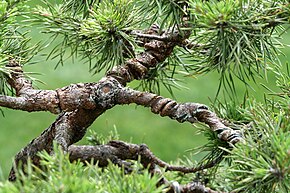Wiring
Wiring ( Jap. 針金掛け , Harigane-Kake ) is a technique for shaping of woody plants . The technique is used in the design of bonsai .
Bonsai are in a small planter solid trees and shrubs , which by suitable measures (z. B. wiring, forming , root and leaf section ) in its growth limits and in accordance with aesthetic design goals in a desired growth form are brought.
The technology
The aim of the wiring is to change the position of the still malleable trunks and branches of young plants. Young shoots usually grow upwards, towards the sunlight. The wiring makes it possible to force the shoots in a downward growing direction and to give the plant the appearance of an aged tree.
Trunks or branches are wrapped with a wire, usually before the start of the growing season . Usually anodized aluminum wire or annealed, flexible copper wire with a diameter of 1.5 to 3 mm is used. A trunk is wrapped in a spiral from bottom to top and the wire is previously anchored in the substrate at the base of the tree. Branches and twigs are wrapped from the trunk to the outer shoot tips.
After wiring, the plant can be bent manually and shaped into its chosen position. The plant part in question now remains in the desired shape.

The wire is removed before it begins to grow into the bark. Ingrown wires can cause deep damage in the bark of the tree, which is only very slowly overgrown . Suitable wire scissors are used for removal . The wire, which tightly encloses the bark, is cut into short pieces and carefully removed so as not to damage the tree.
literature
- Johann Kastner: Growing, designing and maintaining bonsai . Gräfe and Unzer, Munich 2013, ISBN 978-3-8338-3452-3
- H. Kruse: The Japanese bonsai . In: German tree nursery . tape 20 , no. 10 , 1968, ISSN 0011-992X , p. 274-281 .
- Jochen Pfisterer: indoor bonsai . Gräfe and Unzer, Munich 2011, ISBN 978-3-8338-2211-7

